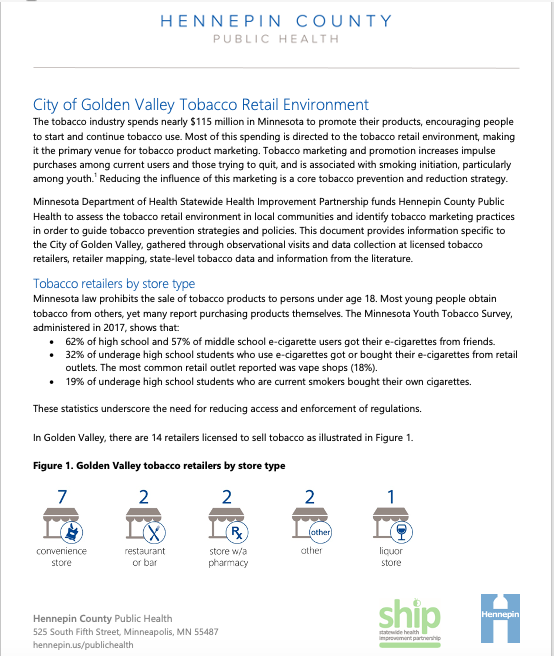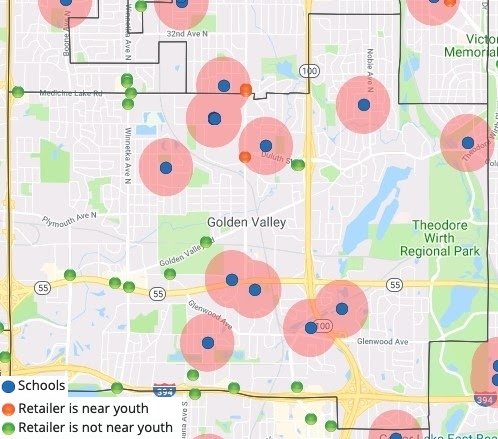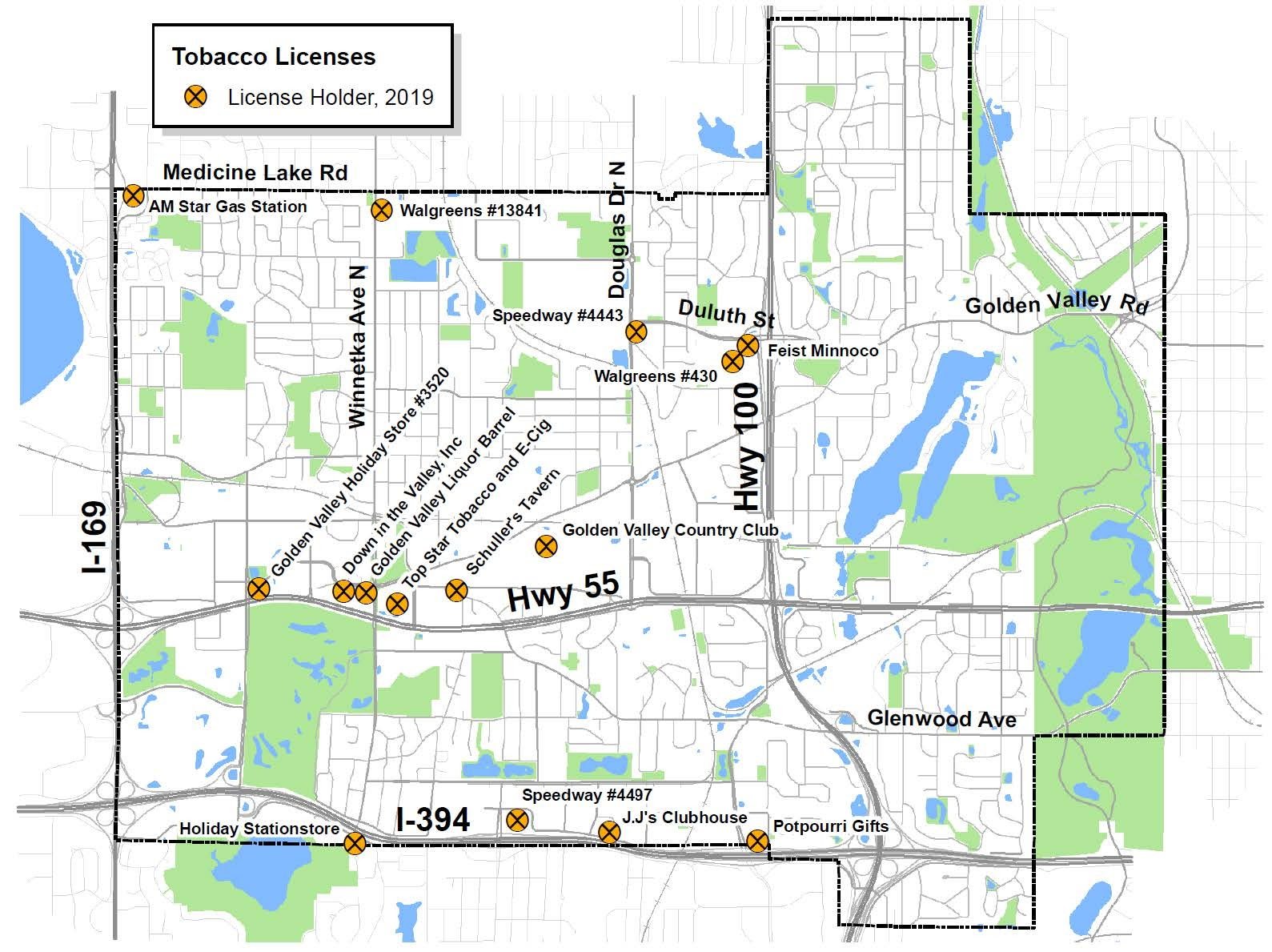Project Description
Overview
In October 2019, the suburban city of Golden Valley in Hennepin County, Minnesota passed a number of comprehensive tobacco prevention policies. These policies covered a broad range of prevention strategies, including raising the minimum legal sales age to 21, banning the sale of flavored tobacco products, increasing tobacco product pricing, capping the number of tobacco retailer licenses issued, increasing penalty fees for tobacco retailers, and more. In June 2020, they passed additional regulations under the city’s zoning code to restrict the location of tobacco retailers and their proximity to youth-oriented facilities. The use of local data, education efforts, and strong political and community support helped pass these policies.
Since 2012, Counter Tools has partnered with the Minnesota Department of Health (MDH) to help support local areas in the state in their pursuit of policy change around tobacco. Policy successes like in Golden Valley show how policy, supported by data, can be used as a mechanism to reduce exposure and access to tobacco especially for those most at-risk like youth.
Background
MDH works with communities across the state to build their capacity and readiness along with providing support for policy change to fulfill the aims of reducing tobacco use and chronic disease in the state. MDH’s partnership with Counter Tools aims to equip and empower Minnesota’s local grantees (under the Statewide Health Improvement Partnership, or SHIP program) with knowledge and data that can be incorporated into efforts around community education, awareness building, and policymaking.
The main focus of Counter Tools’ work with local grantees is equipping them with tools to collect and understand data about the point-of-sale (i.e., brick and mortar stores/retailers where tobacco products are sold). Using one of Counter Tools’ proprietary data collection tools, the Store Audit Center, local grantees conduct store assessments at tobacco retailers to identify what/how tobacco products are marketed and sold. In 2018, for example, 1,651 store assessments were successfully completed across the state by local grantees.
After data collection, this assessment data is cleaned and analyzed by Counter Tools to identify patterns and trends. Infographics are then created by Counter Tools to help summarize this data, which local grantees can use for communication and engagement with key stakeholders.
This store assessment process is supplemented with an online mapping tool, the Store Mapper, which Counter Tools provides to the state. This tool visualizes tobacco retailer locations and density as well as tobacco retailer proximity to venues such as parks and schools. With this tool, the data can be visualized directly on the map and through downloadable reports for specific areas, including the entire state as well as counties and cities.
Strategy
It is important to understand the tobacco retail environment, or point-of-sale, as this is where tobacco enters communities, but not where it stays. The visibility and accessibility of tobacco products in retailers increases tobacco use initiation, makes it harder for smokers to quit, and keeps people addicted.
In March 2019, Hennepin County Public Health (HCPH), one of MDH’s SHIP grantees, conducted store assessments at the city of Golden Valley’s 14 licensed tobacco retailers. The Store Audit Center was used to collect this assessment data and the data from these assessments was also shown in the Store Mapper. This showcasing of the data helped explain the tobacco landscape in Golden Valley.
The findings from these assessments are addressed in a report that HCPH created titled, “City of Golden Valley Tobacco Retail Environment”, using the “4 P’s of marketing” in the retail environment – place, product, price, and promotion. HCPH also created another report titled, “Impact of Tobacco in Golden Valley.” This report addressed the 2019 Minnesota Student Survey data for school districts that Golden Valley students attend, provided demographics (e.g., income, race) as related to tobacco use, and discussed the impact of tobacco use on chronic conditions such as obesity and heart disease. Additionally, mapping data was used to show the density and location of tobacco retailers, as well as the proximity of these retailers to each other and venues such as schools.

In July 2019, the city of Golden Valley began community outreach, asking residents to provide input on regulation of tobacco sales through an online survey. In August 2019, the city hosted an interactive public forum on the regulation of tobacco sales. They invited Ruth Tripp and Gretchen Garman from HCPH along with the Association of Non-Smokers (ANSR) MN to share tobacco research, data and information related to the tobacco prevention policies under consideration by the city. Golden Valley gathered input and feedback from community members and businesses who attended. In order to expand their reach, the city also live streamed elements of this forum and continued to promote the online survey to the community to gain input.
At the forum, and during subsequent communications and presentations, HCPH distributed and presented on the reports they created, the “City of Golden Valley Tobacco Retail Environment” and “Impact of Tobacco in Golden Valley.” They also shared information on effective practices in reducing exposure and access to tobacco products and marketing.
Furthermore, the Public Health Law Center (PHLC), a legal technical assistance provider for local grantees, provided their expert review of Golden Valley’s proposed policies. In addition, the Golden Valley city attorney attended a workshop provided by the PHLC on effective tobacco control practices and how to develop a model ordinance.
Data Insights
Through using mapping data from the Store Mapper, a new understanding of the landscape of tobacco retailers in Golden Valley was cultivated. As of March 2019, the mapping data showed that Golden Valley:
- Had a density of 1 retailer per 1,537 residents
- Had 1 retailer within 1000 feet of a school
- Had two retailers within 500 feet of another retailer licensed by Golden Valley and two within 500 ft. of another retailer licensed by a bordering city.
In addition to these data points, below is a visual of tobacco retailers near schools in Golden Valley from the Store Mapper:

Golden Valley city staff referenced these maps from the Store Mapper, and also created their own map further detailing the presence of tobacco retailers in the city:

Through understanding data and observing visuals like the above, information can be gleaned about where tobacco retailers are located and their accessibility to certain populations like youth.
Along with this mapping data, HCPH identified significant observations about tobacco advertising, the presence of flavored tobacco products, and tobacco products at low pricing through doing store assessments. Out of the 14 tobacco retailers assessed in the city in March 2019,
- Nearly all (86%) sold cigarettes, including menthols, and over half sold cigarillos or little cigars, chew, and e-cigarettes
- Over one-third sold single cigars; all of the retailers had this product available for less than $1.00
- 50% had price promotions on tobacco, most often for menthol cigarettes and smokeless products
- Common practices were employed that appeal to youth: tobacco products placed near youth-oriented products (21%), tobacco products in self-service displays (7%) and tobacco product’ advertising within three feet of the floor, or kids’ eye-level (14%)
Data gives a strong evidence-base when developing and implementing policy. The assessment and mapping data were strategic elements that helped bring awareness to and educate the Golden Valley’ City Council and community on the tobacco landscape and its impact on citizens.
“Utilizing the resources provided by Counter Tools has given us the opportunity to share the landscape of tobacco in a given community. The collected data demonstrates the importance of bringing awareness and education on tobacco prevention policies to community members and city leadership. We look forward to completing tobacco retailer observations next summer to learn the impact of policies passed on tobacco retail environments.”
Results
As a result of this data and community support, in October 2019, the city of Golden Valley passed the following comprehensive tobacco prevention policies, which went into effect on January 1, 2020:
- raised the minimum legal sales age (MLSA) to 21
- banned the sale of flavored tobacco products, including menthol/mint/wintergreen
- restricted the sale of cigars, sold individually or as a multi-unit package, for less than $3.00 per cigar
- placed a cap on the number of tobacco retailer licenses issued at 8 retailers
- made pharmacies ineligible for receiving a tobacco license
- prohibited smoking/vaping for the purpose of sampling tobacco products
- prohibited the distribution of samples of any tobacco product free of charge or at a nominal cost
- increased penalties for violations (including the lookback period, fines, and suspensions)
- increased the licensing fee to cover the cost of additional compliance checks
- added language about child protective packaging, general updating of definitions, and licensure requirements
Further, in June 2020, the city of Golden Valley passed the following additional tobacco regulations under the city’s zoning code, which went into effect the same month:
- tobacco retailers would be limited to the city’s commercial zoning district and considered restricted use (i.e., new retailers could not be located in mixed use districts)
- a 500-foot proximity restriction between tobacco retailers and youth-oriented facilities, defined as schools, parks, playgrounds, and athletic fields
A comprehensive approach that addresses the “4 P’s” using a combination of policies along with education and enforcement helps limit tobacco use and reduce tobacco-related harms. In particular, reducing youth exposure to tobacco products and marketing ultimately reduces youth tobacco use in communities. The passing of the Golden Valley policies was an important step in reducing youth access to tobacco products in the city and had the added benefit of addressing exposure to tobacco products and marketing for other members of the community.
Next Steps
HCPH continues to work towards policy change and is currently in the process of measuring the impact of policy over time. Store assessments will be completed again in summer of 2021 to assess the impact of city policies. Additionally, in 2021, Counter Tools will create infographics for select cities in Hennepin County to help visualize and understand the new assessment data. These findings will be shared with Golden Valley, providing an opportunity for the city to revisit their policies and make additional changes if needed and look towards the future.
Many other local areas in Minnesota have had policy successes like in Golden Valley. Minnesota provides a great example of strong efforts to advance policy through local action.
Published December 16, 2020

